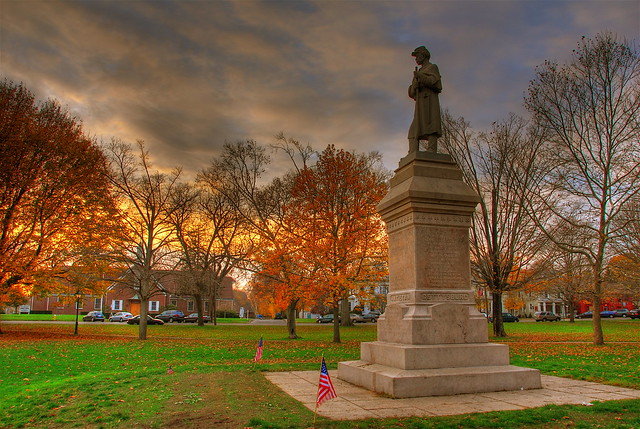So far in this series I've written about Christoph Gielen, a photographer who uses aerial imagery of suburban development to make commentary on current urban design paradigms. I've also brought you into orbit and introduced you to astronaut Don Pettit who took you on a global tour of cities at night. But in this third (and likely final) post in this series, I'm going to take you closer to home. My home, that is.

Guilford, Connecticut is a small town 14 miles east of New Haven on the shore of Long Island Sound. Founded in 1639, the town is host to hundreds of historic homes, a variety of natural amenities including beaches and wetlands, rolling hills and bluffs, and is also characterized by a community ethic of preservation and conservation that protects these assets.
If you've taken an urban studies class with me, you should be familiar with Guilford. It is a usual topic of mine for projects, papers, and presentations. For example, I've written on the history of the Town Green, one of the largest in New England, I've profiled Guilford's Plan of Conservation and Development, a model document for land use planning, and I've written about Guilford's effort to block a proposed Costco development at exit 57 off of Interstate 95.

But how does Guilford fit into the theme of this series? In the late 1990s, renowned urbanist, author, and Yale professor Dolores Hayden took to the air with photographer Alex MacLean to document what they refer to as Guilford's cultural landscape. They define this idea as a "broader way of analyzing architectural, economic, and environmental forces together, to look at how a society shapes its space over time." Where preservationists, planners, and conservationists examine at each of these elements individually, this approach produces a more comprehensive look at how they interact.
In a companion essay to their aerial portfolio (also a great history of development in Guilford), they describe the role aerial photographs play in capturing cultural landscape in a detailed and accessible way:
Aerial images can capture the preserved parts of a town's cultural landscape, and can also help identify the threatened parts and the shape of land use conflicts, present and potential. Low-level, oblique-angle pictures of many parts of the town can establish a more complete visual inventory than ground-level shots. They can show inaccessible places, such as wetlands or steep terrain. They can reveal usually hidden sites, such as dumps or gated communities.... They convey the vast scale typical of twenty-first century development, and can bring up-to-the-minute data on the progress of sprawl. And, best of all, they are understood by people without technical training, in a way that zoning maps, zoning codes, satellite surveys, and traditional site plans are not.Let's take a look at some of their photographs.

We'll start off with the most important landmark in Guilford, the Town Green. The green serves as the central gathering space for town events including high school graduation, an annual handcrafts fair and other cultural events, town parades, and dozens of other community functions. The retail, municipal, and religious institutions lining the green also make it the nexus of activity in Guilford.

Do you notice anything interesting or odd about the image above? Route 1, the road running horizontally through the center of the picture, is also the dividing line of one of Guilford's historic districts. Just look at the difference in the (somewhat) dense neighborhood of old homes and the asphalt of the shopping center across the street. Bonus question: Can you find the octagon-shaped house?

Finally, the completion of Interstate 95 through Guilford in 1958 brought about a population explosion that would change the town forever. More people meant an increased demand for housing, and developments like the one above sprung up throughout town, mostly in the wooded areas north of the highway.
To see the rest of the aerial portfolio, click here.
Hayden and MacLean conclude their commentary with the following: "In 1935, the architect Le Corbusier wrote, 'The airplane indicts.' He claimed that anyone flying over old French towns would see the need to tear down and rebuild to his modernist designs. We suggest the opposite. Aerial photography with a hand-held camera heightens awareness of unique cultural landscapes by documenting land use in an accessible way.... They can help architecture buffs and environmentalists, citizens and specialists, visualize common ground."
This vision of the common ground is what I find so striking about these images, and what I hoped to share with you. Guilford is a place I very much admire - in many ways my experiences growing up there set me on my current path of study and it seems only fitting that I return to it now as an example community for questions regarding urban development.
No comments:
Post a Comment